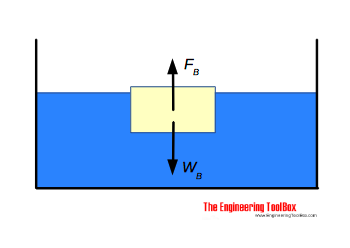
Pressure will increase as you go deeper into a fluid, the force exerted by pressure on the top of the can of beans will be smaller than the force exerted by pressure on the bottom of the can. The principle of buoyancy is also called Archimedes ’ principle, as it was discovered by this Greek mathematician in the third century BC. We can derive a quantitative expression for the fraction submerged by considering density. Buoyancy is caused by pressure differences acting on opposing sides of an item immersed in a static fluid. Therefore, the net buoyant force is always upwards.\), for example, the unloaded ship has a lower density and less of it is submerged compared with the same ship when loaded.

However, because pressure increases with depth, the upward push on the bottom surface (F2) is greater than the downward push on the top surface (F1). This weight is equal to the mass of the displaced fluid multiplied by the gravitational acceleration:īuoyant force: The fluid pushes on all sides of a submerged object. The buoyancy force on the cylinder is equal to the weight of the displaced fluid. Now, we’ll calculate this force using Archimedes’ principle. In the previous section, we calculated the buoyancy force on a cylinder (shown in ) by considering the force exerted on each of the cylinder’s sides. We will explore this further as we discuss applications of the principle in subsequent sections.Īrchimedes’ Principle – Simple Example: We use Archimedes’ Principle to determine the number of penguins an ice float can dryly support. The Archimedes principle is valid for any fluid-not only liquids (such as water) but also gases (such as air). Therefore, the buoyancy force on the original object is equal to the weight of the “displaced fluid” (in this case, the water inside the dashed region (b)). However, we also know that the buoyancy force on the fluid must be equal to its weight, as the fluid does not sink in itself. The buoyancy force on this amount of fluid must be the same as on the original object (the ship). Because density mass/volume, then volume mass/density 500/3.2 156.25 cm 3.

Imagine that we replace the submerged part of the object with the fluid in which it is contained, as in (b). With the concept of Buoyancy, you need to explain the Archimedes principle or flotation principle and then correlate it with the students previous concepts. The reasoning behind the Archimedes principle is that the buoyancy force on an object depends on the pressure exerted by the fluid on its submerged surface. same pressure environment, it follows that the buoyant force on the solid object is equal to the weight of the water displaced (Archimedes principle). According to him, when a body is wholly or partially immersed in a. The principle can be stated as a formula: Archimedes determined the amount of buoyant force exerted by the liquid on the body. In other words, to calculate the buoyant force on an object we assume that the submersed part of the object is made of water and then calculate the weight of that water (as seen in ).Īrchimedes principle: The buoyant force on the ship (a) is equal to the weight of the water displaced by the ship-shown as the dashed region in (b). BBC Bitesize 2nd level What is buoyancy Part of Science Forces Video Transcript I wonder why that twig is sitting on top of the water like that. A simpler method follows from the Archimedes principle, which states that the buoyant force exerted on a body immersed in a fluid is equal to the weight of the fluid the body displaces. This happens because fluid pressure increases with depth.

Thus, the net upward force on the cylinder due to the fluid is:Īlthough calculating the buoyant force in this way is always possible it is often very difficult. Buoyancy is the ability or tendency of an object to float in a fluid, which can be a liquid or a gas. Because it is cylindrical, the net force on the object’s sides is zero-the forces on different parts of the surface oppose each other and cancel exactly.

Similarly, the force on the bottom surface is:Īnd points upwards. The magnitude of the force on the top surface is:


 0 kommentar(er)
0 kommentar(er)
